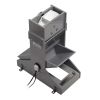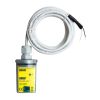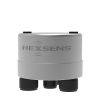KISTERS Single Tipping Bucket Flow Gauges
Features
- Bucket tip volume set at 0.5L or 1L per tip
- Maximum flow rate of 25 liters per minute
- Includes 24VDC dual reed switch
- Expedited repair and warranty service
- Lifetime technical support
- More
Overview
The KISTERS single tipping bucket flow gauges TB0.5L and TB1L are used for measuring water seepage coming out of a pipe or a drain. In both models, the bucket is connected to its own dual reed switch, effectively enabling redundant data acquisition in two distinct data loggers, or providing data to two devices (e.g. a data logger and a counting display), etc.
Design
TB0.5L and TB1L are perfectly suitable for flow measurements in water-carrying sediments or iron hydroxide deposition. Made of plastics and coated steel, these devices are both robust, fast and easy to clean.
Mechanics
The bucket tips when it is filled to maximum. The magnet integrated into the bucket rearside slides along the reed switch mounted in the flow gauge’s frame. The magnetic field forces a contact closure in the reed switch. The latter can be recorded by one or two connected data loggers. The number of tips per time unit is a measure of the flow rate.
| Material | PVC plastic and stainless steel | ||||||||||||||||
| Resolutions | PVC bucket: 0.5 L or 1.0 L (selectable), up to 25 L/minute | ||||||||||||||||
| Accuracy |
|
||||||||||||||||
| Signal Out |
|
||||||||||||||||
| Flow Rate | Maximum 25 L/minute | ||||||||||||||||
| Level | Bulls eye level adhered to stainless steel base | ||||||||||||||||
| Environmental Conditions |
|
||||||||||||||||
| Dimensions & Mass |
|
In The News
Save our Bogs! Culture, Conservation and Climate Action in Ireland’s Peatlands
Characterized by long-term accumulation under waterlogged conditions, peatlands exist on every continent and account for 3-4% of the global land surface . Small but mighty, these often overlooked wetland environments are estimated to hold as much as one-third of the world's organic carbon in their soil—twice the amount found in the entirety of the Earth's forest biomass. While healthy peatlands can trap and store carbon, regulate water, and provide important habitats for rare species, human alteration has disturbed peatland carbon and nitrogen cycles on a global scale. Approximately 12% of the world’s peatlands have been drained and degraded through conversion for agriculture, forestry, infrastructure development, and other uses.
Read MoreSargassum Surge: How Seaweed is Transforming our Oceans and Coastal Ecosystems
Until recently, Sargassum –a free-floating seaweed–was distributed throughout the Sargasso Sea , the north Caribbean Sea, and the Gulf of Mexico. But in the space of a decade, this seaweed has, as one scientist remarks , “Gone from a nonfactor to the source of a terrible crisis.” Driven by climate change, anomalous North Atlantic Oscillation in 2009-2010 and a glut of anthropogenic pollutants, sargassum has proliferated. Seasonally recurrent mats as deep as 7m now bloom in the “Great Atlantic Sargassum Belt” (GASB), which covers areas of the Atlantic from West Africa to the Caribbean Sea and Gulf of Mexico. Every year, millions of tons wash up along the shores of more than 30 countries . Dr.
Read MoreGreat Lakes Research Center: Designing Targeted Monitoring Solutions
According to the National Oceanic and Atmospheric Administration ( NOAA ), the Great Lakes have more miles of coastline than the contiguous Atlantic and Pacific coasts combined and contain 20 percent of the world's freshwater, making it a critical region to protect and conserve. Continuous monitoring and data-informed resource management are key components of managing waters in the region. Hayden Henderson, a research engineer with the Great Lakes Research Center (GLRC), designs and deploys monitoring platforms throughout the Great Lakes. With a background in environmental engineering, Henderson enjoyed the challenge of creating systems and making them work to obtain difficult, remote measurements.
Read More










